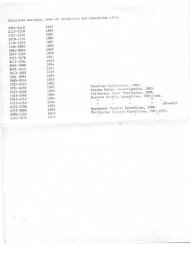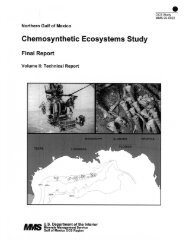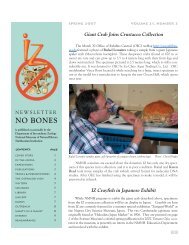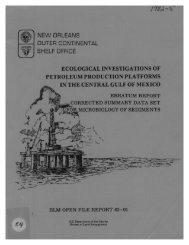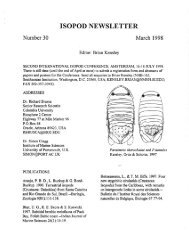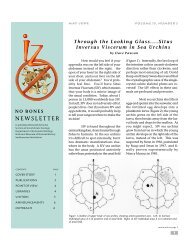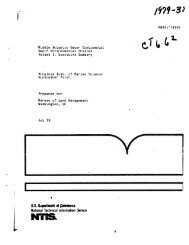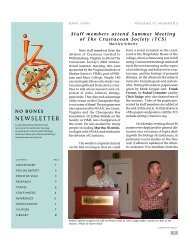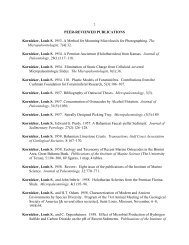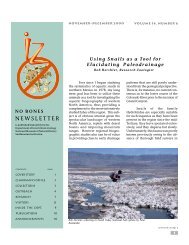Isopod Newsletter 23 - Department of Invertebrate Zoology
Isopod Newsletter 23 - Department of Invertebrate Zoology
Isopod Newsletter 23 - Department of Invertebrate Zoology
- No tags were found...
Create successful ePaper yourself
Turn your PDF publications into a flip-book with our unique Google optimized e-Paper software.
Ley, J. A., C. L. Montague & C. C.McIvor. 1994. Food habits <strong>of</strong> mangrovefishes: a comparison along estuarinegradients in northeastern FloridaBay.--Bulletin <strong>of</strong> Marine Science54(3):881-899.Marques, J. C., I. Martins, C.Teles-Ferreira & S. Cruz. 1994.Population dynamics, life history, andproduction <strong>of</strong> Cyathura carinata Kroyer(<strong>Isopod</strong>a: Anthuridae) in the MondegoEstuary, Portugal.--Joumal <strong>of</strong> Crustacean-Biology 14(2):258-272.Messana, G. 1993. A new Stenasellus(Crustacea, <strong>Isopod</strong>a, Stenasellidae) fromthe Eastern Province <strong>of</strong> Kenya and noteson Kenyan Stenasellidae. --Tropical<strong>Zoology</strong> 6(2):441-449.Miller, R. G. 1993. History and Atlas <strong>of</strong>,the fishes <strong>of</strong> the Antarctic Ocean. ForestaInstitute for Ocean and Mountain Studies,Carson City, Nevada. 792 pages. [Severalmentions <strong>of</strong> isopods in the diet <strong>of</strong>Antarctic fishes]Moran, J. A. G. & J. Arrontes. 1994.Factors affecting food preference in awidespread intertidal isopod.--Journal <strong>of</strong>Experimental Marine Biology and Ecology182(1): 111-121.Moulin, C. M. & R. K. Maika. 1994.Endogenous circadian rhythm <strong>of</strong>emergence and swimming activity <strong>of</strong> thedeep water isopod Cirolana borealisLiUjborg.--Marine Behaviour andPhysiology 24(3):151-163.Miiller, H.-G. 1994. Janiridae from coralreefs at the Society Islands, FrenchPolynesia (Crustacea:<strong>Isopod</strong>a). --Zoologische Abhandlungen,Staatlisches Museum fUr Tierkunde,Dresden 48(1):1-13.Miiller, H.-G. 1994. Redescription <strong>of</strong>Excorallana oculata (Hansen, 1890) fromthe Caribbean Sea <strong>of</strong> Colombia (Crustacea:<strong>Isopod</strong>a: Corallanidae).--ZoologischeAbhandlungen, Staatlisches Museum fUrTierkunde, Dresden 48(2):15-22.Mutlu, E., M. Unsal & F. Bingel. 1992.A preliminary view on the faunalassemblage <strong>of</strong> s<strong>of</strong>t-bottom crustaceansalong the nearshores<strong>of</strong> the Turkish Black Sea.--Acta Adriatica33(1/2): 177-189.Nair, G. A. & A. A. Aljetlawi. 1993.Observations on the body dimensions andthe ecological factors <strong>of</strong> the soilinfluencing the abundance <strong>of</strong> the pillbugArmadilla <strong>of</strong>ficinalis Dumerill, 1816(<strong>Isopod</strong>a: Oniscidea) in Benghazi,Libya.--Journal <strong>of</strong> Animal Morphologyand Physiology 40(1/2):61-71.Nair, G. A., F. A. Attia & N. H. Saeid.1994. Food preference, feeding andgrowth rates <strong>of</strong> the woodlouse Porcellioscaber Latreille, 1804, (<strong>Isopod</strong>a,Oniscidea, Porcellionidae) . --AfricanJournal <strong>of</strong> Ecology 32(1):80-84.Nara, M. 1994. What is the producer <strong>of</strong>"trace fossil <strong>of</strong> Excirolana chiltoni"? -Tracemaking mechanism <strong>of</strong> Macaronichnussegregatis.--Fossils 56:9-20.6



